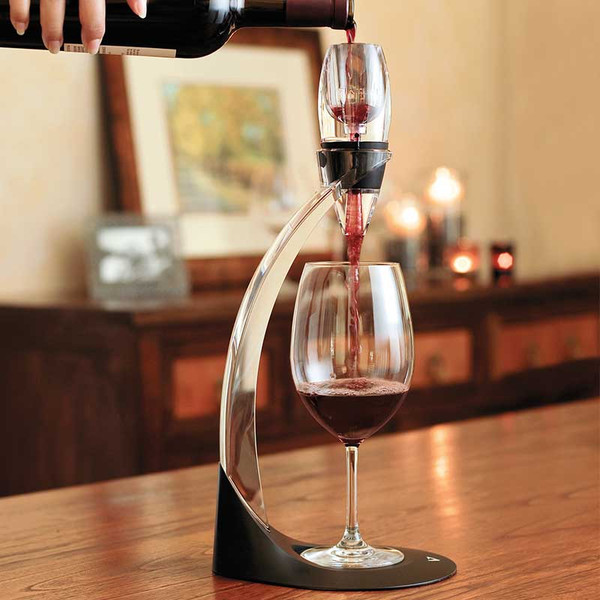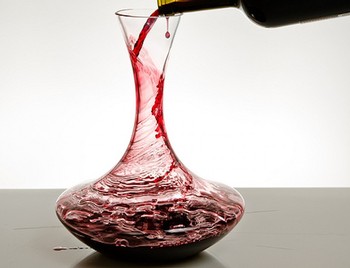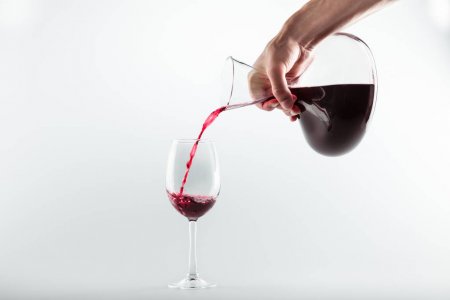Why Aerate Wine?
Do wine aerators really make a wine taste different?
Simple answer.. because it makes all red wines and some white wines taste heaps better!
Every customer so far has prefered the aerated wine 'the aerated wines seems smoother, with a bit more to it.' The aerated wine is more lifted, bigger and brighter. The more full-bodied reds open up and show more complexity after the extra air contact. 
How does Aeration work?
Aeration works by allowing the wine to oxidise.
The increased oxidation softens the tannins and seems to smooth out the wine.
Aerating plays a huge part in enhancing your drinking experience; first off, it releases a wine's beautiful aroma. The aeration creates bubbles this increases the surface area allowing the wine to show off its beautiful scents.

While in the bottle, wine is reacting with oxygen and constantly changing, just at a slower rate than when it's out of the bottle.
In a sense, aerating wine is mimics or speeds up the wine's ageing, so effectively giving you a snapshot of the wine's cellaring potential.
And of course, this means you are going to get the very best out of the wine you are drinking today!
A marvellous way of not having to decant a whole bottle is by using one of these amazing pourers. It aerates your wine as you pour! And the best bit...if you haven't finished the bottle, you've only aerated the wine your drinking.
If you aerate wine by decanting the bottle and don't finish the bottle, as you've speeded up the ageing process the wine is unlikely to be any good the next day.

What wines should I aerate?
- Young tanic wines, with a lot of attitude
- aeration will help the tannins to mellow a bit, softening any harsh edges in the wine and making it a more pleasant drinking experience that isn’t overpowered by a tannic punch.
- Effectively wine aeration is trying to replicate the wine’s natural aging process, and tries to make up for lost years bottled in the cellar within an hour of open oxygen exposure. Both ways help break down harsh tannins.
-
Aged Red wine with visible sediment
- Red wines are often aged, after a while various elements in the wine, such as tannins and other chemicals, begin to bind together, solidify, and sit as a sediment on the bottle of your wine bottle.
- This usually occurs between eight and ten years of aging, although this depends on the type of red wine being stored, the conditions of its storage, etc.
- The sediment of aged wine can taste bitter - which makes sense, it is mostly tannins
- So it’s always a good idea to segregate the sediment while you’re decanting aged wine.
- To do this - remove the bottle from its aging rack (it has probably been laid sideways). Stand it upright for a day to allow the sediment to slowly float down and settle at the bottom of the bottle.
- When you’re ready to decant the wine, pour very slowly so as not to mix the wine and sediment on the bottom, and keep an eye out for when to stop pouring. Make sure the murky wine and sediment on the bottom stays in the bottle, and doesn’t pour out into the decanter with the rest of the wine.
- Some white wines
- Some whites can also highly benefit from aeration. These whites are usually dry, full-bodied, and with heavier mouth feels than other whites.
- Reserve Chardonnay & aged Verdelhos
Decanting Wine

Decanting wine is another way of aerating your wine.
Decanting is usually best for full-bodied red wines or wines that have aged. It does 3 essential things:
- Aerates
- Catches Sediment
- Increases surface area in which the wine can release the aroma.
Over time, as a red wine ages, the Tannins clump together and fall to the bottom of the bottle forming sediment. This sediment is not very tasty and should be avoided at all costs. If you allow wine to sit in a decanted for an hour or more, the sediment will fall to the bottom of the decanter and be caught in the dimple at the bottom, making the wine you drink from it free from sediment, while also aerating.
If you are having guests over for dinner who enjoy red wine, make sure you crack the bottle and pour it in a decanter at least 30 minutes before they arrive. Don't be scared to give it a swirl to slosh it around, this will open up the wine perfectly.
You're now ready to enjoy wine at it's fullest potential.
Warning: you will need to drink it all that night! After all that aeration the wine will taste 'past it' the next day.
Mind you I like an achievable goal!
Cheers!


